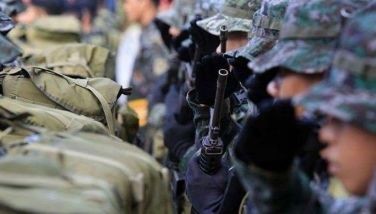Many Filipino sailors wind up aboard ‘sweatships’
July 17, 2003 | 12:00am
The ITF counts 20,906 FOC ships, mostly from Panama, where a third of the crew of Panamanian-flagged ships are Filipinos; Liberia (where 12.8 percent of the crew are Filipino); Cyprus (11 percent Filipino); Malta (8.2 percent) and the Bahamas (7.9 percent).
The ITF’s casualty list in 2001 saw the loss of 99 ships topped by the FOC registers of Panama (15), Cyprus (8), St. Vincent (8), Cambodia (7) and Malta. Thirteen FOC registers also accounted for 63 percent of losses in terms of gross tonnage.
The ill-fated Norwegian Cruise Line’s (NCL) SS Norway is but a recent addition to the list of FOC ships that have claimed Filipino seafarers’ lives (see table). Owned by the Malaysian firm Star Cruises, the Norway was built in 1962 and was once the world’s longest cruise ship. Like the rest of the NCL’s fleet of luxurious passenger liners, it is registered in the Bahamas. In May, the Norway’s boiler exploded, killing eight crew members, including seven Filipinos. The blast also left scores injured.
Preliminary investigation results of the SS Norway tragedy have described it as "an accident with no warning," assessing no blame on anyone. Ten days before the explosion, the ship also passed a major annual inspection of the US Coast Guard on its machinery, safety and navigational equipment.
Yet the SS Norway has a troubled history. Two years ago, the US Coast Guard barred the ship from leaving Miami due to improper repairs on its defective sprinkler system. Troubles with its boilers began in May 1981, when these failed and the ship drifted for a day. Then in December, a boiler-room fire forced the cancellation of two cruise schedules, while another fire in March 1982 delayed a cruise for a few hours.
The government’s deployment strategy, however, does not consider the flags carried by ships because, says Ramon Tionloc Jr., a center director at the Philippine Overseas Employment Administration (POEA), these "have nothing to do with their seaworthiness."
"You also have to consider that these FOCs are managed by good companies," he adds.
Nelson Ramirez, president of the United Filipino Seafarers (UFS), also says that seafarers should be grateful that there are flags of convenience. "We won’t be able to board any ship without the FOCs," he says. "Panamanian and Liberian FOC ships employ most of our seafarers. An FOC ship is not necessarily bad."
That, however, is only partly correct. Filipinos are also able to board national flag ships via the country’s second register – like the NIS (Norwegian International Ship Register), DIS (Danish International Ship Register) and GIS (German International Ship Register) – which allows seafarers from other nationalities to join their own crew. One of the reasons is that seafaring has lost its attractiveness in the developed economies, which now have to rely on developing countries like the Philippines for their labor supply.
ITF general secretary David Cockroft does admit that there are also bad ships under genuine national flags, which its inspectors are trying to bring into the ITF fold with the help of seafarers themselves. But there is a big difference, he explains, in that a genuine link between the flag and the country indicates that seafarers can expect some protection from the flag state and its courts.
"With an FOC, if the flag state gets tough, the owner can just shift to another flag," he says, adding that the impulse to violate labor and safety standards is there because there is not much accountability.
But Doris Magsaysay-Ho, CEO of the Magsaysay Maritime Corp., a pioneer shipping and ship-manning company in the country, says that "safety has become the most important thing in the world today," and that ship owners are really serious about this shift.
"Who would want anybody to get hurt?" she asks. "Who would have thought that the (SS Norway’s) boiler would blow up? A lot of us tend to have this mindset that because ships here sink, the owners seem to don’t care. But these are really the mom-and-pop operations, those using wooden boats run just by anybody in the family in their tsinelas."
Since 1998, the International Maritime Organization (IMO) has adopted the International Management Code for the Safe Operation of Ships and for Pollution Prevention, or the ISM Code. To ensure enforcement of the minimum standards of competence for seafarers, the IMO revised and adopted the provisions of the International Convention on Standards of Training, Certification and Watchkeeping for Seafarers (STCW) in 1995.
In addition, several agreements now allow the inspection of foreign ships entering national ports to ensure they meet IMO standards.
BrandSpace Articles
<
>
- Latest
- Trending
Trending
Latest






























